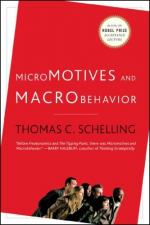
|
| Name: _________________________ | Period: ___________________ |
This test consists of 5 short answer questions, 10 short essay questions, and 1 (of 3) essay topics.
Short Answer Questions
1. Why might segregation result without discrimination?
2. How does Schelling describe a critical-mass behavior?
3. How does the heating system parallel human behavior in Schelling's example?
4. What does Schelling say the farmer needs to know?
5. How do people affect each other's decisions where to sit in theater?
Short Essay Questions
1. What distinction does Schelling draw between decisions other people have made?
2. How do economic systems resemble ant colonies, in Schelling's analysis?
3. What would be the consequence of parents preferring boys to girls, in Schelling's analysis?
4. What is the critical-mass model?
5. What is the behavioral model that would make arms reduction a self-fulfilling prophecy?
6. What are discrete variables and continuous variables?
7. Which U.S. presidents' decisions about nuclear weapons does Schelling describe?
8. What would the demographic consequences be, if parents could select the traits of their children?
9. How does Schelling use mathematical formulations to express his economic models of behavior?
10. What methodological difficulty does Schelling see in a college where the population is 75% female, with a handful of black students?
Essay Topics
Write an essay for ONE of the following topics:
Essay Topic 1
Can you speak accurately about the character of a people based on any particular model? Or can you only speak accurately about individuals whose motives you know and whose behavior you have discussed with them? Put another way, what are the limits of the kind of knowledge Schelling practices in Micromotives and Macrobehavior?
Essay Topic 2
Which models are most convincing in predicting outcomes, and which models are least convincing? Describe a case where a model lines up neatly with phenomena, and another case where a model fails to account for behavior.
Essay Topic 3
What institutions or roles is the social scientist playing by analyzing, predicting and trying to influence human behavior? Is the social scientist a preacher, engineer, or artist? What roles does he take, and how is the social scientist different? Cite examples from the book as you make your answer.
|
This section contains 1,023 words (approx. 4 pages at 300 words per page) |

|




